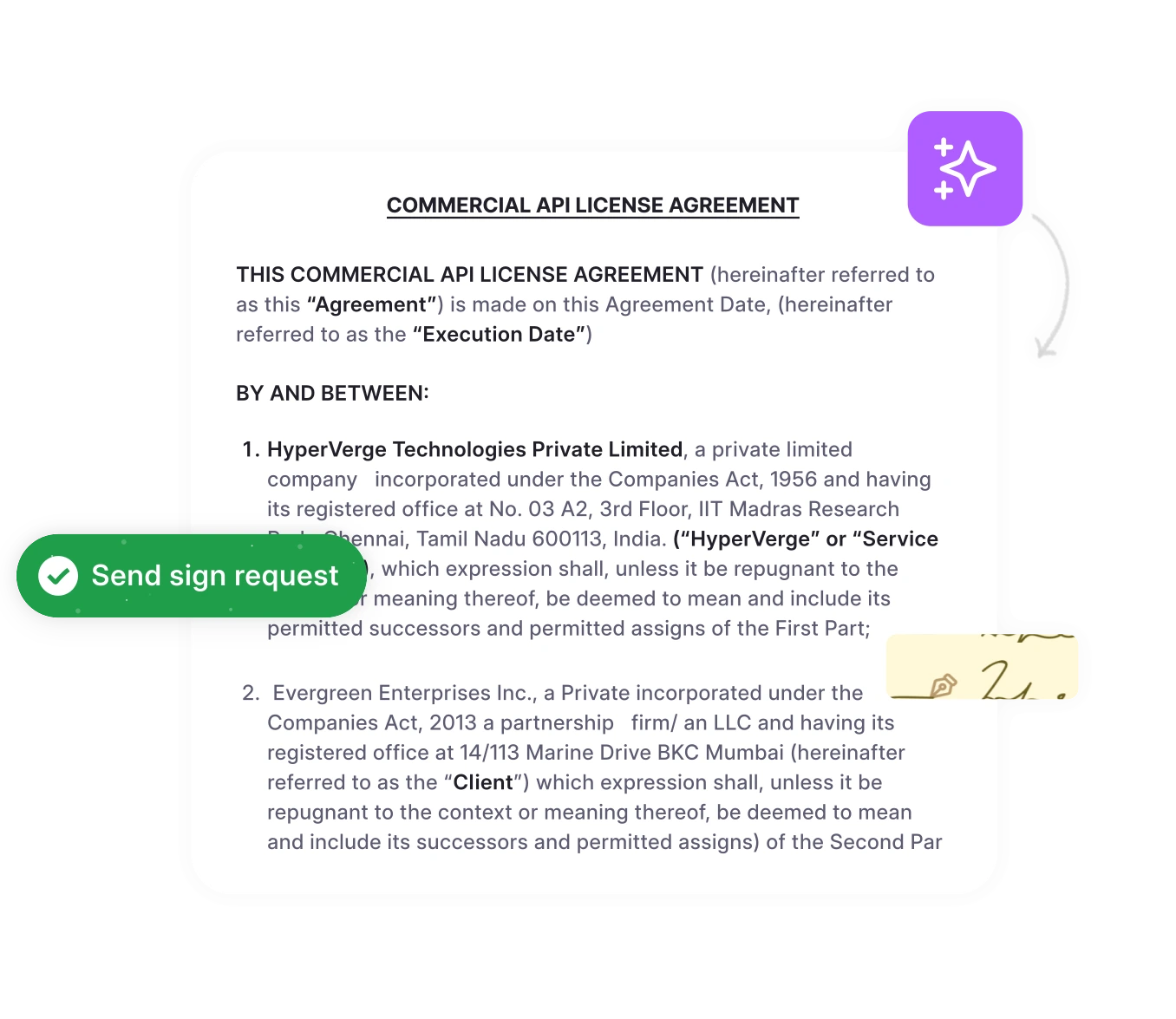Managing contracts is a team effort where departments like legal, sales, operations, finance, and risk management come together to handle their shares in the lifecycle. However, non-legal teams often lack contract expertise, increasing risks and inefficiencies.
The consequences are delays in drafting, weak negotiations, disorganized workflows, and revenue loss. As per World Commerce and Contracting, poor contract management costs companies 9% of their annual revenue.
The solution? Using a contract playbook—a structured guide streamlining contract processes, providing legal instructions, and ensuring team consistency and compliance.
This blog is your guide to understanding contract lifecycle management playbooks: what they are, why they are needed, and how to create one. Let’s get started.
What is a contract playbook?
A contract playbook is a comprehensive guideline that regulates contract lifecycle management in an organization. It is a single source of truth containing information on key CLM stages like contract drafting, review, negotiation, and approval.
Contract playbooks are the cornerstone of contract management processes and help standardize CLM operations. It is a resource and guide for legal professionals, contract managers, and non-legal teams like sales and procurement for handling contract-related tasks.
The playbook has all the necessary components to help business staff self-manage contracts without needing assistance from contract lawyers or legal professionals. Let’s take a look at the components and contents of a contract playbook.
What are the components of a contract management playbook?
Each contract type has its own playbook. For example, the playbook for an NDA and sales contract would contain different components. Nonetheless, here are the common basic components of a contract playbook:
1. Preferred legal language
Standardized legal language ensures consistency and reduces ambiguity in contracts. It saves time during drafting and negotiation, minimizing legal risks by avoiding vague or non-compliant terms.
2. Pre-approved clause library
Provides a repository of pre-approved clauses for various scenarios, enabling faster drafting and reducing the time spent on legal reviews.
3. Contract templates
Offers ready-to-use templates for frequently used contracts like NDAs and MSAs, reducing drafting time and ensuring adherence to the playbook’s standards.
4. Fall-back positions
These are pre-approved alternative clauses or positions to use during negotiations. They help maintain flexibility while protecting the organization’s core interests, ensuring faster deal closure without compromising compliance.
5. Roles and responsibilities
Clearly defines who is responsible for drafting, reviewing, negotiating, and approving contracts, ensuring accountability and smoother workflows.
6. Negotiation strategies
Outlining contract negotiation tactics ensures that legal and business teams approach discussions with a clear plan. This minimizes disputes, aligns with organizational goals, and equips teams to handle counter-arguments effectively.
7. Approval process
A defined approval hierarchy streamlines decision-making, prevents bottlenecks, and ensures compliance with internal policies. It also reduces risks by involving the right stakeholders at critical points.
8. Rationale statements
Rationale statements explain the reasoning behind key clauses or positions. This promotes clarity among team members, reduces misinterpretation, and ensures alignment with business objectives.
9. Explanation of legal concepts
Simplifies complex legal jargon for non-legal stakeholders, fostering collaboration and reducing the risk of misunderstandings during contract reviews.
10. Policies and procedures
Provides a framework for contract management, ensuring compliance with organizational and regulatory standards. This reduces risks and promotes consistency in handling contracts.
11. Escalation points
Defines when and how disputes or critical issues should be escalated to higher authority. This ensures that significant risks are addressed promptly and appropriately.
12. Checklist items
Serves as a quality control tool, ensuring that all essential elements are reviewed and included before contract finalization. This reduces errors and enhances contract accuracy.
13. Contract wording
Clear, standardized wording reduces ambiguity and legal risks. It ensures consistency across contracts, making them easier to understand, negotiate, and enforce while aligning with the company’s legal standards.
14. Amendment instructions
Contracts often require updates. Amendment instructions provide a structured process for making changes, ensuring that revisions are legally compliant, properly documented, and reviewed by the right stakeholders.
15. Valuable contract data
Key contract data (like renewal dates, obligations, and milestones) helps teams track performance, manage risks, and ensure compliance. Having this data readily available supports data-driven decisions and proactive contract management.
16. Language index
A language index defines legal terms, clauses, and contract-specific jargon. This ensures that non-legal teams understand key terminology, reducing misinterpretation and improving cross-department collaboration.
Ready to optimize your contract management?
Book a demo with HyperStart today and take your contract playbook to the next level.
5 Benefits of using contract negotiation playbooks
As a centralized, comprehensive resource for contract management, playbooks help not only legal professionals and contract managers but also sales, procurement, finance, and other departments fulfill their roles in the contract lifecycle management process. Here’s how:
1. Enables non-legal teams to self-serve contracts
Creating a contract from scratch can take anywhere from a few days to weeks or even months, depending on the contract’s complexity, requirements, and the lawyer’s skills. However, this timeline isn’t viable when contracts are required urgently by teams like sales and procurement.
A contract playbook helps speed up the contract generation process by empowering non-legal teams to self-draft agreements. Playbooks offer pre-approved clauses and templates that all departments can use as starters for contract drafting—saving valuable legal time.
2. Speeds up review and negotiation cycles
Review and negotiation cycles help identify problematic clauses, secure favorable deals, and improve a contract’s value. However, reviewing, redlining, and negotiating a contract without a clear direction or guidelines can extend negotiation cycles and delay signing.
Contract management playbooks speed up the negotiation process by providing clear guidelines, terms, and strategies for contract review. Additionally, playbooks outline negotiation limits and fallback terms, ensuring smooth, favorable contract negotiations.
3. Improves contract management workflows
Drafting, reviewing, approving, and signing contracts is a team effort and involves multiple stakeholders from departments like sales, operations, finance, and legal. However, there are instances where the roles and responsibilities of these stakeholders are not defined—creating friction in the contract lifecycle.
A playbook defines different stakeholders’ key roles and responsibilities in the contract management process. This helps establish accountability and responsibility in CLM, promoting more structured contract approval workflows and reducing friction.
4. Helps save time spent on legal referral
Drafted contracts are often passed to the legal department for legal review. This consumes valuable legal time on repetitive activities like answering questions, providing input, and verifying clauses.
A playbook acts as a legal expert, helping non-legal teams to get answers to all their contract-related questions. Detailed guidelines enable non-legal teams to get legal advice on agreements—saving legal professionals’ time on referral activities.
5. Promotes use of standard approved language
When drafting contracts at scale, there is a high chance that different lawyers will use different legal terminology and jargon. However, divergent contract language often leads to missed provisions, causes legal loopholes, and even increases review time.
A contract playbook acts as a lawyer’s reference guide. It contains approved clauses, templates, and legal language. This way, using a playbook helps ensure consistency in legal drafting where all of the organization’s contracts are legally sound and fulfill business interests.
Manage contracts 80% faster
Leverage legal AI tech with HyperStart CLM—your reliable contract management software. Get more done with less effort.
So far, we have covered what goes into a contract lifecycle management playbook and why it is needed. Now, let’s find out how to create and use a contract playbook.
How to create a contract playbook
Here’s the step-by-step process for creating a playbook that your in-house legal teams and other departments can use:
1. Choose a contract playbook format
Start by determining whether your contract playbook will be a physical document, a spreadsheet, or a digital format integrated into contract management software.
Digital playbooks are dynamic, easily accessible, and navigable, making them the go-to choice for most organizations.
Some organizations also choose to use tools like Notion or Google Docs to create and manage their contract playbooks.
2. Add relevant information to the playbook
Include key contract clauses, fallback positions, negotiation strategies, and escalation points.
Define the preferred legal language and rationale for each clause to maintain consistency.
Outline approval workflows, policies, and compliance standards to align with internal processes.
Incorporate checklists to ensure completeness before contract execution.
3. Address stakeholders’ interests and concerns
Identify the priorities of legal, finance, sales, and procurement teams to align the playbook with business objectives.
Gather feedback from stakeholders to ensure the playbook addresses common negotiation challenges.
Define roles and responsibilities for contract review, approval, and escalation to prevent delays.
4. Establish metrics for playbook compliance checks
Define contract management KPIs such as contract turnaround time, deviation rates from standard clauses, and approval bottlenecks.
Implement tracking methods to monitor how frequently fallback positions are used.
Set up automated compliance checks using contract management software to ensure adherence.
You can use HyperStart CLM’s analytics dashboard to track compliance, negotiation timelines, and risk exposure effortlessly.
5. Train and onboard team members on the playbook
Conduct training sessions for legal, procurement, and sales teams to ensure proper adoption.
Provide real-life contract scenarios to demonstrate how to apply the playbook effectively.
Create a user-friendly guide or FAQ section to address common queries.
6. Regularly maintain and update the playbook
Schedule periodic reviews to align the playbook with legal regulations and business needs.
Gather user feedback to refine clauses, fallback positions, and negotiation strategies.
Monitor industry trends and competitor contract practices to enhance the playbook.
Leverage contract lifecycle management (CLM) platforms to automate updates and track compliance guidelines.
With HyperStart CLM, automate version control, ensuring your playbook stays current without manual tracking.
Ready to boost your legal ops?
Switch to HyperStart CLM— the one-stop platform to create, review, negotiate, approve, store, and track contracts using AI.
Automate contract management with HyperStart CLM
Contract playbooks are excellent tools for standardizing and streamlining contract lifecycle management. They serve as guidelines—empowering business teams to self-manage contracts.
Using HyperStart CLM, you can empower your legal, administration, and operation teams with the right platform to manage contracts.
With HyperStart CLM, you can:
Turnaround contracts 80% faster
Cut short contract admin time by 70%
Boost negotiation cycles by 75%
Review contracts 10x faster
Save $20 per contract
Want to know more about how HyperStart CLM can benefit your organization? Book a demo with our team today for a discovery call and get started with a 14-day free trial.









![How to Negotiate SaaS Contracts [A Guide]](https://www.hyperstart.com/wp-content/uploads/2025/02/Blog-60-purple-scaled.webp)


